Leh, Ladakh, India - His Holiness the Dalai Lama was today invited to a lunch in his honour at Abi-Spang Spituk by the Ladakh Buddhist Association (LBA) and the Ladakh Gonpa Association (LGA). Despite the persistent and untimely rain His Holiness reached the venue where he was welcomed by Ven Dorjay Stanzin, President of the LGA. He paid homage to His Holiness and thanked him for his kindness to the people of Ladakh over many years. He welcomed Thiksé Rinpoché and all the other guests.
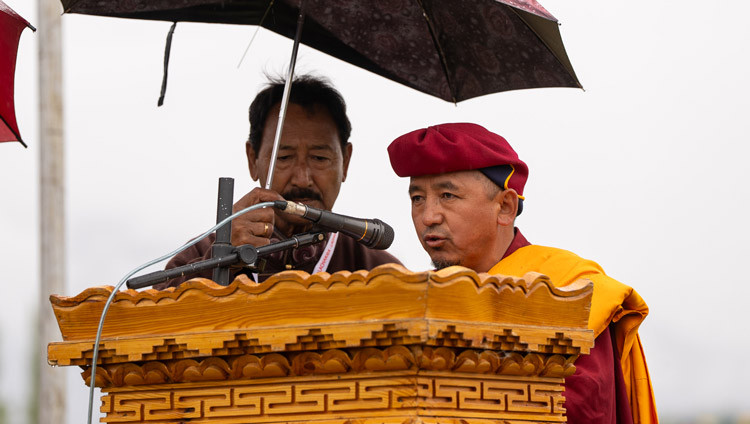
Women from the village of Spituk dressed in their best clothes performed the first of three cultural presentations singing and dancing with grace and joy to a traditional musical accompaniment. Next, a large group from Sonamling Tibetan Settlement sang and danced, their exuberance not dampened by the rain. The audience, meanwhile, enjoyed the show sheltering from the rain under umbrellas.
His Holiness made the following remarks:
“Monastics and lay-people, Ladakhis and Tibetans, have organized this celebration today with great dedication. We Tibetans talk about people from the Three Provinces including the land from Dartsedo in the east to the western region of Ngari which is adjacent to Ladakh. We Tibetans had the opportunity to cross the border and feel we were very much the same as the people of Ladakh who share our religion, culture and language.
“I’d like to thank you for organizing this event here today.
“I mentioned the Three Provinces of Tibet—in the central part of the Land of Snows the Tibetan government mostly concerned itself with that part of the country. However, I generally talk about the Three Provinces of Tibet which are home to six million Tibetans. We are all people of the Land of Snows sharing the same religion, culture and language. I was born in Dhomé, Amdo, which is one of the three provinces.
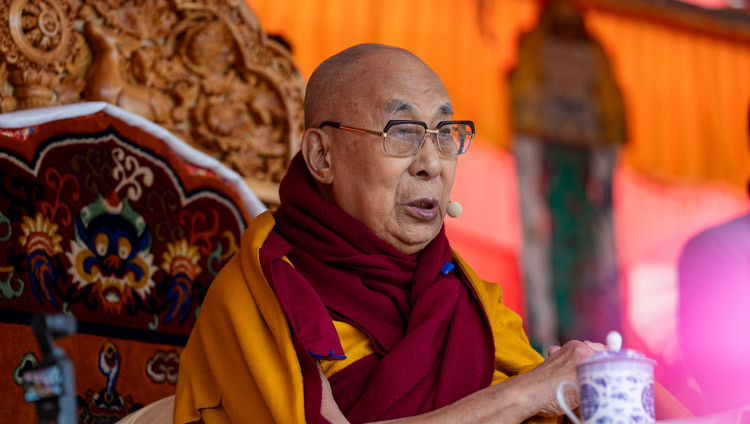
“When I had the opportunity to visit different parts of Tibet, I had a very strong feeling that we are all one people. I was born in the vicinity of Siling in Amdo. Although the place was far from the central region, we shared a common religious and cultural heritage. When I talk about the Three Provinces of Tibet, I’m not motivated so much by politics as by a recognition that we, the people of the Three Provinces, are one.
“The Chinese communist regime’s occupation of Tibet follows a political agenda, and yet all Tibetans feel they belong to the Land of Snows which is comprised of the Three Provinces. Under the name Tibet, the Land of Snows, we have a strong sense of being Tibetan. Those of us who are from Dhotö, Dhomé and U-tsang, make up the six million Tibetans. All of us, whether we are happy or sad, have the same sense of being Tibetan.
“I have been to many different parts of Tibet and heard the different dialects spoken there, but the people living in those places have the same sense of being Tibetan. Right now, we’re in a land bordering Tibet and as Tibetans we have a strong sense of being one people. This spirit is strong and clear in us and I’m very happy to see it.
“We have monasteries and nunneries where we have preserved our spiritual tradition. In Central Tibet we have the three major monastic seats of learning. There are also great monastic institutions in Kham and Amdo. They preserve the essence of our cultural tradition.
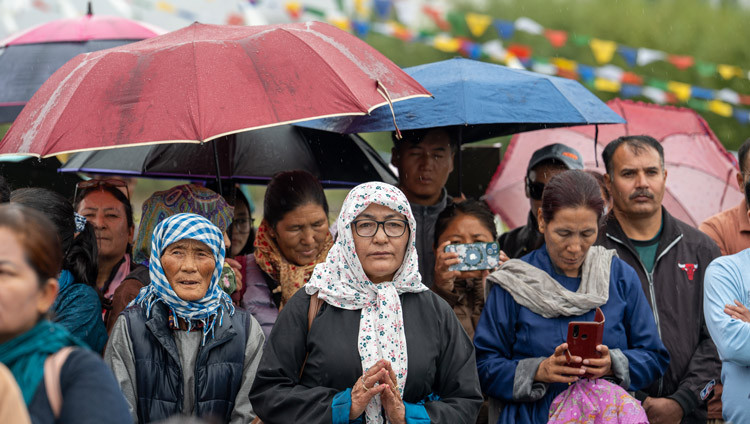
All the people of the Three Provinces have a strong feeling of belonging to one people, people with one religion, culture and language. It’s very important to recognise this.
“Here I am in Ladakh, bordering on Tibet. As I’ve said, Tibetans have a strong sense of being one people. This is not a political statement. Since the time of Songtsen Gampo there were great Tibetan translators who translated Indian religion and culture into Tibetan. They gave us the Translations of the Words of the Buddha, the Kangyur, and translations of Commentarial Treatises, the Tengyur. These contain the teachings of the Buddha.
“From the eastern part of Tibet, on the border with China, right up to Ladakh, we have the same language, culture and religion. It’s not that we are attached to these aspects of our tradition, but this culture we uphold is derived from the teachings contained in the Kangyur and Tengyur. These are what we have preserved and continue to study and practise.
“Our major monastic institutions are centres of learning that are integral to our preservation of the Buddha’s teachings. Neighbouring countries have also worked to preserve the Buddha’s traditions, but we have adopted a different approach. We have engaged in rigorous study based on logic and reason.
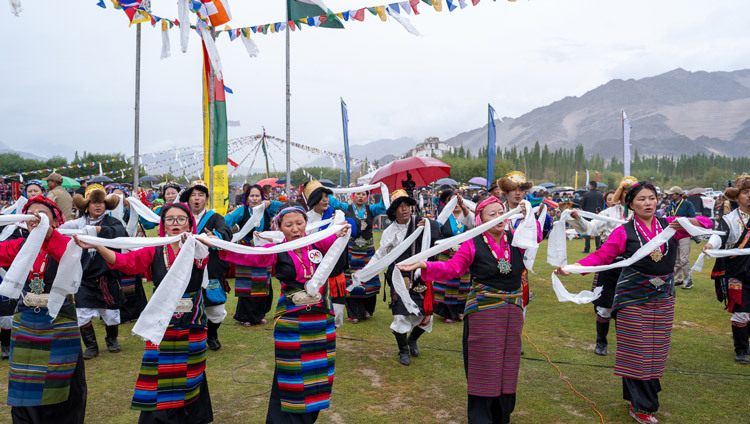
“Although China is the powerful country ruling Tibet today, Tibetan cultural traditions have even spread there. Chinese people have strong interest in and admiration for the Tibetan Buddhist tradition which serves a beneficial purpose for them. Tibetan religion and culture is precious. This tradition has also been preserved in the border regions of Tibet for a thousand years.
Although I was born in Dhomé,. I moved to Lhasa, the location of the throne of the Dalai Lamas. Thanks to the kindness of my Tutors, I have studied the major topics of the Buddhist curriculum from logic up to the Perfection of Wisdom, the view of the Middle Way (Madhyamaka), Knowledge (Abhidharma) and Monastic Discipline (Vinaya). I don’t have much interest in the way Abhidharma describes the universe, but my studies of the other subjects were very helpful.
“If you have some understanding of the Perfection of Wisdom, the Middle Way as well as Logic and Epistemology you can feel you have a thorough knowledge of the Buddha’s teaching. If you are not familiar with these subjects, even if you can recite Abhidharma by heart, your understanding will not be very comprehensive.
“Then there is Tantra. Our tradition includes the four classes of Tantra, which means we have a transmission of the complete teachings of the Buddha. The essence of all these teachings is learning about the workings of our mind and emotions, how to deal with negative emotions in order to discipline our unruly minds. Through this kind of study and practice, what we are doing is working to become a Buddha for the benefit of all.
“Other traditions do not include such extensive study and practice. The kind of deep knowledge of Buddhism that we have is not found elsewhere. We mainly focus on the Middle Way and Logic. We study the five canonical subjects thanks to the scholar-adepts of the past. This is an excellent tradition. I have studied the texts of classic Buddhist literature—this is what comprises our cultural tradition.
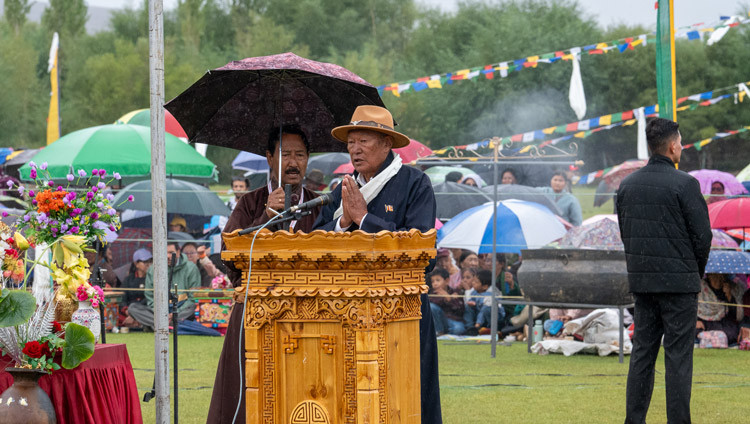
“Here in Ladakh, which borders Tibet, you also have great enthusiasm for our shared Buddhist traditions. And this makes me very happy. In my efforts to contribute to your efforts to preserve this Buddhist tradition, I have been able to give teachings here and I’m very glad about that. Thank you.”
The President of the LBA offered words of thanks. He expressed gratitude to His Holiness and to everyone from Spituk who had made the ground available and taken part in other aspects of organizing the event. The Spituk villagers performed the Shödöl Dance to conclude the celebrations. Finally, after eating lunch, His Holiness returned to Shewatsel Phodrang.












